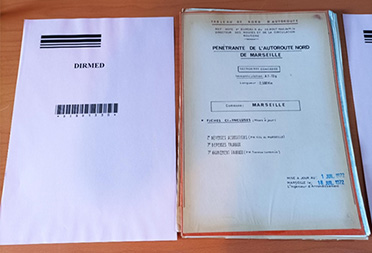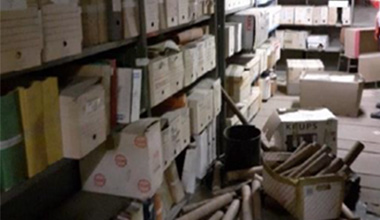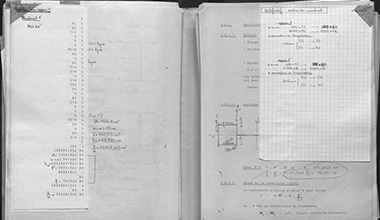
The DIR-MED is one of eleven interdepartmental road directorates in mainland France and is responsible for the operation, maintenance, traffic management and modernisation of several hundred kilometers of national roads and non-concession freeways in the Provence-Alpes-Côte d’Azur and Occitania regions.
“The directorate needed to streamline its archives, inventorise the material in its collection and digitise certain documents for its engineers,” explains AGS Records Management archivist and project leader Camille Potard.
Like many organisations, the DIR-MED struggled to keep an accurate inventory of its physical archives. This made it hard for engineers and technicians working on road maintenance and development to access important material. They mainly used digital tools but missed the valuable information found in the physical documents. This was especially problematic because the archives trace the history of urban development policy in the region, the building of major roads, and construction techniques.
Helping customers define their needs

To address this knowledge gap, the directorate turned to AGS Records Management for help with its collection which is housed in the District Urbain de Septèmes-les-Vallons.
The aim? To digitise and index the building plans of all public works and create a database for use by the engineers and technicians in charge of road maintenance and development.
“In the first phase, we helped the client define their needs. This included finding out which information the engineers need to do their jobs,” explains co-project lead Ambre Monier.
The expert archivists then collated, sorted and classified the directorate’s technical and administrative files, processing almost 290 linear meters in all.
Next, they processed the civil engineering collection, which included 145 meters of plans, technical notes, and correspondence about public works in the Bouches-du-Rhône region, dating from 1875 to today. It also contained rare documents such as road accident reports from the 1940s and watercolour profiles of public works from the early 20th century.
The need for accurate descriptions

“We uncovered gaps and contradictions from one era to the next, so we were in regular contact with the client to refine and standardise the terminology to be used. It was a challenge because, while there is a methodology behind creating documentary descriptions, we also had to incorporate highly technical architectural terms. To repair a leak, for example, engineers need to be able to identify the structure exactly and trace all its components from when it was first built,” explains Camille Potard.
In total, the two archivists worked for nine months preparing the documents for digitisation. This involved eliminating duplicates (almost 30% of the collection), removing any metal and plastic elements, and creating metadata descriptions for each document.
Each description contained the document’s key information, a precise description, and a unique reference number. Together, they totalled 33,000 lines of files to be processed by the digitisation team. “Our descriptions had to be clear, concise and short enough for the digitisation operators, whose requirements we also had to take into account,” explains Ambre Monier. “It was challenging, but also informative to have to identify only the essential information and convey it well.”
Ensuring that all documents are faithfully copied, that their metadata is reliable and that they are classified in a tree structure
The digitisation team ensured that each digital file was an exact replica of its physical equivalent. They made the archives easier to access by scanning the documents, adding metadata, and creating a taxonomy that categorised each file by road, road section, and structure name.
A true team effort
The success of the project depended on the strong coordination and communication between the two AGS Records Management teams along the entire processing chain, all managed by one project leader to ensure high-quality results.
Scientific and technical supervision was provided by the Bouches-du-Rhône Departmental Archives, which also approved all processes.
Thanks to the AGS teams, the DIR-MED was able to save space by sorting the documents and ensuring their long-term preservation. Today, the entire archive of civil engineering works is digitised, indexed, and classified according to a clear taxonomy.
Take control of your data with AGS’s expert digitisation services. Say goodbye to clutter and hello to efficiency. Contact us now to transform your archives into a powerful digital resource today.
Ambre MONIER – Archiviste







